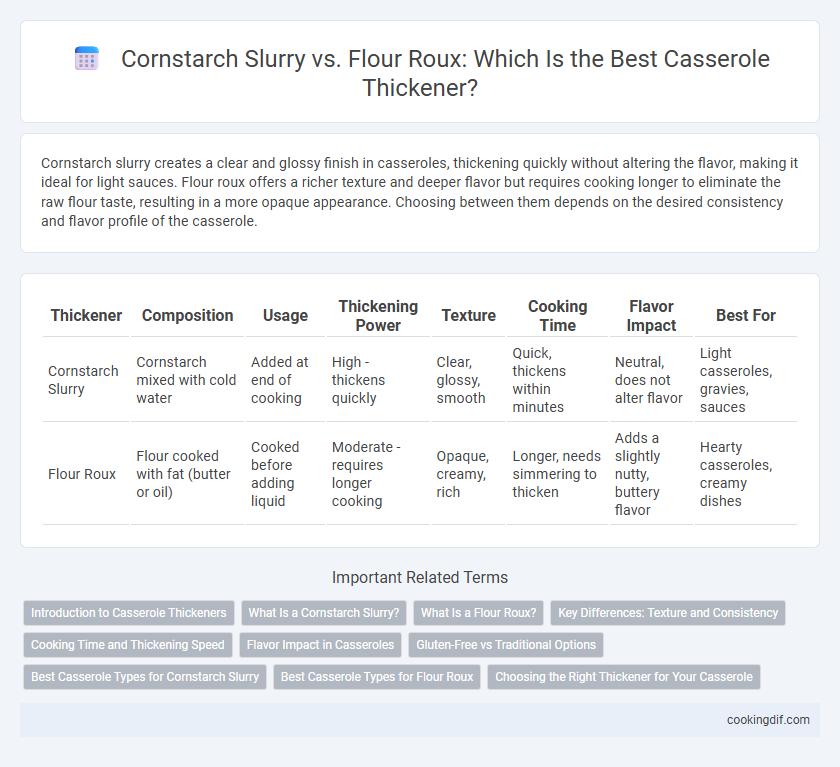Cornstarch slurry creates a clear and glossy finish in casseroles, thickening quickly without altering the flavor, making it ideal for light sauces. Flour roux offers a richer texture and deeper flavor but requires cooking longer to eliminate the raw flour taste, resulting in a more opaque appearance. Choosing between them depends on the desired consistency and flavor profile of the casserole.
Table of Comparison
| Thickener | Composition | Usage | Thickening Power | Texture | Cooking Time | Flavor Impact | Best For |
|---|---|---|---|---|---|---|---|
| Cornstarch Slurry | Cornstarch mixed with cold water | Added at end of cooking | High - thickens quickly | Clear, glossy, smooth | Quick, thickens within minutes | Neutral, does not alter flavor | Light casseroles, gravies, sauces |
| Flour Roux | Flour cooked with fat (butter or oil) | Cooked before adding liquid | Moderate - requires longer cooking | Opaque, creamy, rich | Longer, needs simmering to thicken | Adds a slightly nutty, buttery flavor | Hearty casseroles, creamy dishes |
Introduction to Casserole Thickeners
Casserole thickeners like cornstarch slurry and flour roux play crucial roles in achieving the desired texture and consistency in dishes. Cornstarch slurry, made by mixing cornstarch with cold water, provides a clear, glossy finish and thickens quickly at lower temperatures, making it ideal for delicate casseroles. Flour roux, created by cooking flour with fat such as butter, offers a richer flavor and a more opaque, creamy texture, with a slower thickening process that enhances hearty casseroles.
What Is a Cornstarch Slurry?
A cornstarch slurry is a mixture of cornstarch and cold water combined to create a smooth, liquid thickener for casseroles and sauces. When added to a hot liquid, the slurry thickens quickly without altering the flavor, producing a glossy finish. Cornstarch slurry is preferred over flour roux for its faster thickening properties and gluten-free nature, making it ideal for casseroles requiring clear, smooth sauces.
What Is a Flour Roux?
A flour roux is a classic thickening agent made by cooking equal parts flour and fat, typically butter, until it forms a smooth paste. It develops a rich, nutty flavor and adds a creamy texture to casseroles, making it ideal for dishes that require a hearty consistency. Unlike cornstarch slurry, which thickens quickly and remains glossy, a flour roux provides depth of flavor and stability for slow-cooked casseroles.
Key Differences: Texture and Consistency
Cornstarch slurry provides a glossy, clear finish with a silky, smooth texture perfect for light casseroles, while flour roux yields a richer, opaque sauce that offers a denser, creamier consistency ideal for hearty dishes. Cornstarch thickens quickly at lower temperatures and requires less cooking time to eliminate its raw taste, whereas flour roux demands longer cooking to develop flavor and avoid graininess. Texture differences affect mouthfeel, with cornstarch creating a more delicate, less viscous coating compared to the robust, velvety body produced by flour roux.
Cooking Time and Thickening Speed
Cornstarch slurry thickens casseroles quickly, often within 1-2 minutes of cooking, making it ideal for recipes with shorter cooking times. Flour roux requires more cooking time, usually 10-15 minutes, to eliminate the raw flour taste and achieve full thickening. The faster thickening speed of cornstarch slurry results in a glossy finish, while flour roux produces a richer, more opaque texture.
Flavor Impact in Casseroles
Cornstarch slurry creates a glossy, translucent finish with a neutral flavor that allows the natural tastes of the casserole ingredients to shine. Flour roux imparts a richer, deeper flavor and adds a slight nuttiness due to the browned flour, enhancing the overall savory profile. Choosing between cornstarch slurry and flour roux depends on whether a clean taste or a more complex, hearty flavor is desired in the casserole.
Gluten-Free vs Traditional Options
Cornstarch slurry serves as a gluten-free thickening agent for casseroles, providing a clear, glossy finish and a smooth texture without altering flavor, making it ideal for those with gluten sensitivities. In contrast, a flour roux, traditionally used in many casseroles, combines fat and flour to create a rich, creamy base but contains gluten, which is unsuitable for gluten-free diets. Choosing cornstarch slurry enhances casserole accessibility while maintaining consistent thickness, whereas flour roux offers a classic taste and texture preferred in traditional recipes.
Best Casserole Types for Cornstarch Slurry
Cornstarch slurry is ideal for casseroles with delicate ingredients like seafood or vegetables, as it thickens without altering the dish's flavor or texture. This thickener works best in creamy casseroles such as chicken pot pie or vegetable gratins, providing a glossy finish and smooth consistency. Unlike flour roux, cornstarch slurry offers quicker thickening and clearer sauces, enhancing casseroles with lighter broths or milk-based sauces.
Best Casserole Types for Flour Roux
Flour roux is ideal for casseroles with creamy, rich sauces like chicken pot pie or macaroni and cheese due to its smooth, velvety texture and ability to develop deeper flavors through cooking. This thickener excels in baked casseroles where prolonged heat allows the flour to fully cook, avoiding any raw taste and providing a stable, luscious consistency. Dishes such as beef stew casserole and creamy vegetable bakes benefit most from a flour roux, enhancing their hearty, comforting profiles.
Choosing the Right Thickener for Your Casserole
Choosing the right thickener for your casserole depends on the desired texture and cooking time; cornstarch slurry creates a clear, glossy finish and thickens quickly at lower temperatures, making it ideal for last-minute adjustments. Flour roux offers a richer, creamier consistency with a slightly opaque appearance and requires cooking the flour and fat together to eliminate raw taste, perfect for casseroles simmered longer. Consider the casserole's cooking duration and visual appeal when deciding between cornstarch slurry and flour roux to achieve the best thickening results.
Cornstarch slurry vs flour roux for casserole thickener Infographic

 cookingdif.com
cookingdif.com